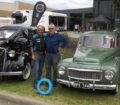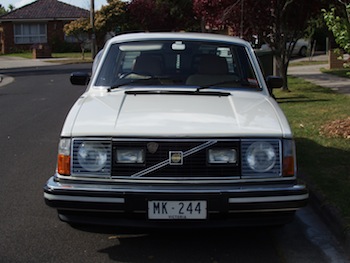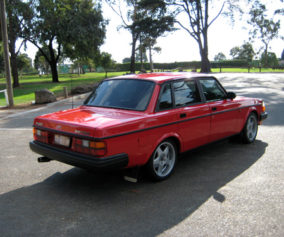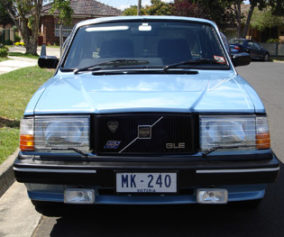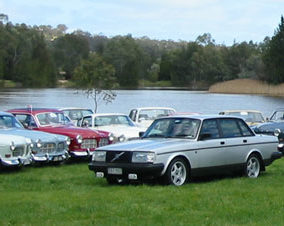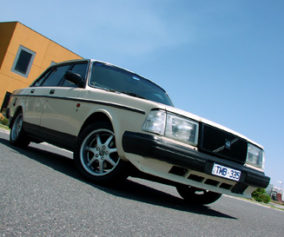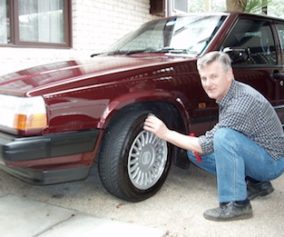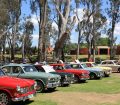Once in a while, and probably once in my lifetime, a car so special comes along that it doesn’t lend itself easily to a brief summary in a space like this, and such is the difficulty I face in trying to put into words some thoughts about my first and favourite Volvo, my white 1976 244DL. It’s now exactly 30 years since this car first graced our driveway, and here it remains as functional, reliable and dare I say beautiful as it always has been, even if it’s limited use and pampered existence these days is far from the many miles it once travelled and loads it once carried as a hard-working family car. This anniversary seems like as good a time as any to pay tribute to “one of the best”.
A 1970s 240 is probably not the model that immediately springs to most member’s minds when they think of the car that stirs their passions for things automotive, but most of us do have a special attachment to the first Volvo we ever owned or drove, and the first time I climbed behind the wheel of this car as a 16 year-old learner, I knew that I would always drive a Volvo and that I wanted one just like this! There was something about the total feel of this car that’s hard to define, from it’s sure-footed and true handling to it’s compliant ride, smooth torque, predictable steering, confident brakes and precise gearshift that hooked me from the beginning and convinced me that this was a car you could believe in – a true driver’s car designed and built with integrity and to a standard, not a price. I’ve realized ever since that moment that most Australian drivers, not to mention motoring journalists, just never quite got the point about Volvos. But that’s their loss.
I once read in a Volvo sales brochure that you simply can’t expect a really thoughtfully-designed and well-built car to roll of some mass-production line every few seconds, and such is the case with a car like this one which has never failed to impress with it’s build quality, sound common sense engineering and rugged reliability. However Volvo’s greatest strength was also it’s Achilles’ heel, as it is the most important attributes that any car can have; things like reliability, quality, safety and practicality, that also tend to be the most boring – until you need them and find that your car of choice is lacking! However it’s drivers and enthusiasts like ourselves, people who perhaps show more good sense than fickle emotion in our choice of car, who understand the true merit of a Volvo. If you’re someone who wants the latest fad styling or jack-rabbit acceleration, then a car like this one was never the type to own or be seen in, but those things never meant anything to me, and the Volvo 240 series has always fit me like a glove.
My 244 had modest beginnings, sitting idle in a Sydney Volvo showroom for 12 months when new before being shipped to Melbourne and starting out as a local company rep’s car during which it covered nearly 80,000kms in a mere two years of use. Then, at the end of the 1970s, father Peter purchased it as a safe and solid family car to replace his declining Ford Zephyr, and the Volvo was a big step forward over it’s predecessor with disc brakes and fuel-injection, not to mention a cavernous and comfortable interior. I still vaguely recall the day, as a mere four year old, when that transaction took place and the car came home, and being terribly intimidated by those enormous white doors that took so much effort to open and close, and seats that seemed mountainously high off the ground! Little did I know that 30 years later I’d be sitting on those same seats and closing those same doors in a car that has defined my enthusiasm for this hobby.
Peter drove the 244 for the following 19 years before finally updating to the 1993 940 you see on these pages, at which time the older car, still in perfect order in spite of over 350,000kms travelled, passed to me. All that was required for the roadworthy certificate at the time was a rubber steering column bushing and I recall that the mechanic remarked “There’s not much wrong with the bloody Volvo!” long before that expression became popular. Peter can famously tell you that in nearly 20 years of motoring, the car never once made him late for work, and when not commuting with him the Volvo was usually laden with gear and carrying a young family on almost weekly long-distance country runs all over Victoria. Aside from the very occasional alternator failure or drive belt breakage, misfortunes that can befall the best of cars, the 244 was faultlessly reliable. In fact, it’s unfailing consistency is one of the most endearing qualities of this car. As the years passed and others in our neighbourhood inevitably updated from one locally-made or Japanese model to the next, with all the old local and imported classics slowly fading from the scene, the old white 244 has always been here, ageing gracefully and merely in transit from what was initially a prestige European status symbol, to a well kept older car and now, finally, to an immaculate classic that people are just beginning to appreciate and lavish with compliments everywhere it travels.
Dad always felt that a car was there to be used, and used it was, but always with care and respect. Whilst others blame their dirty or rough vehicles on the demands of a family life or simply on the rigours of a car being used everyday, ours was kept in perfect shape by precautions as simple as covering the seats for those winter fishing trips and keeping a good coat of polish and wax on the paintwork. We kids also understood that a car was to be respected and so doors were opened carefully to check for obstacles, dirty shoes or clothes were removed before entering, no messy food was consumed inside and no toys were carelessly allowed to damage interior trim. In fact, aside from the many wonderful upgrades and enhancements made to this car over the years, some of which I’ve discussed below, one of the things I love best about it is it’s originality in which most of the paintwork, fittings and interior trim are that with which it left the factory, and still in as-new condition. After all, anyone with the money and inclination to do so can take an old car and make it new again, but there’s no substitute for a lifetime of care. All you enthusiasts and car-care fanatics with your pristine restorations, just think about that for a moment!
Peter loved his Volvo, and a big part of the enthusiasm involved the nice upgrades that came along from time to time that made the car that much more enjoyable to own and drive, and has helped make it the refined and comfortable car it is today. In it’s original form, the 244DL of the 1970s was a technically advanced but really rather basic car, but the beauty of a Volvo is in it’s incredible commonality of genuine parts, allowing features from more upmarket or later models to simply be bolted on, and over the years dad fitted many features, too numerous to list in full, but including such pleasures as electric windows and mirrors, alloy wheels, power antenna and cruise control, as well as such functional genuine accessories as a rear venetian blind, tachometer, fabric headrest covers, integrated front fog lamps, and floor mats.
When I inherited the car in 1998, it signalled the beginning of a journey that has been a wonderful learning experience in mechanical servicing, repairs and car care, and an ongoing source of satisfaction, pleasure and driving enjoyment. In particular, further upgrading the car with genuine parts and accessories quickly became a real passion of mine, and so I soon picked up where dad left off and added power steering, overdrive transmission and heavy duty stabilizer bars from a GT model to eliminate the body roll in cornering from which the 240s tended to suffer. My real pet subject became and remains learning about and sourcing the myriad of genuine Volvo accessories originally offered for this car, and so began the endless runs to the wreckers and internet searches that over the years have allowed me to hunt down and fit countless fantastic and rare features such as left and right hand floor-mounted storage consoles, retractable front seat centre armrest and rear reading lamps, as well as the more common ones like rear headrests and side weathershields. In fact, each time I feel sure I have learned of and located every conceivable factory accessory or upgrade, I discover something new in some corner of a wreckers yard or on some obscure internet page – and the journey continues.
Not all of my favourite upgrades on this car have been of the genuine accessory or heavy mechanical variety, however, as I’ve made the occasional departure into the realm of tasteful aftermarket customizing where I’ve felt there was a shortfall to be addressed. For instance, this 244 pre-dates Volvo’s generic boot carpeting and instead had a simple vinyl matting as standard, so one of the earliest and best modifications I did was to purchase high-grade black automotive carpeting by the metre and to custom trim the entire boot inside including the otherwise neglected areas of the rear wheel arches and boot side walls, giving it a luxurious appearance as well as adding some very worthwhile sound deadening. A genuine Volvo spare tyre carpet cover completes a finish in which I left no surface uncarpeted! Speaking of sound deadening, I also purchased under-bonnet insulation material and custom fitted it between the ribs of the bonnet underside, again gaining valuable noise-suppression in an area which Volvo addressed as standard at the factory when insulating the 700 series cars, but strangely never with the 240s. Moving to the interior, I once stumbled across some high-tech aftermarket adhesive woodgrain film, and enhanced the otherwise monotone black expanse of the dashboard with some custom-made inlays in a burr walnut finish. I initially tried, and failed, to have a cabinet maker reproduce the original rubber dash pieces out of real wood, and was unsure at first about the merits of the adhesive film, but once fitted the effect was indistinguishable from genuine polished timber and has also lasted the test of time. Think it might look tacky? You should see me fool them at the Volvo dealership!
Back in 2001 I purchased the blue 1985 240GLE you can read about on these pages, and from then on, and for the first time in nearly 25 years, the white 244DL ceased to be used on a daily basis and began to wind down towards the pampered existence of semi-retirement that it enjoys today. For the most part, my 244 can be found at home, garaged and spotlessly clean under a dust cover with it’s wheels polished, tyres blacked, bumpers Armor-alled and paintwork gleaming, ready at any time for a weekend run under sunny skies, a Volvo club activity, or some incremental tinkering by me. And now, with my new undercover carpark at work, the 244 can even resume some occasional commuting if I feel it is unlikely to be rained on during the short trip there and back! As for that tinkering I mentioned, I know that my task list of little improvements and upgrades remains as long as my arm, so there’s no chance of me ever losing interest.
Maybe most importantly, I can be sure that the car will never fail to start and purr like a kitten when I turn the key, even after weeks of sitting idle, and now with nearly 380,000kms logged on the original motor, I know that it will continue to perform well for as long as it is on the road. Whilst others I hear of change engines and major components on these cars and seemingly manage to destroy the undestroyable, my philosophy, like Peter’s before me, remains unchanged: routine servicing is never overlooked, and I never ask more from the machinery than that which is required for normal driving – consequently the machinery lasts forever. After long periods of commuting in other later model Volvos, climbing into this old 244 never feels like a come-down, and whilst some enthusiasts love the nostalgic or stylistic appeal of their classics only to get in and grit their teeth to endure a nightmare of noise and vibration on the road, the 244 always offers a fine level of comfort and familiarity that I simply love. And so it remains.
Mark Hoffmann, October 2009.
